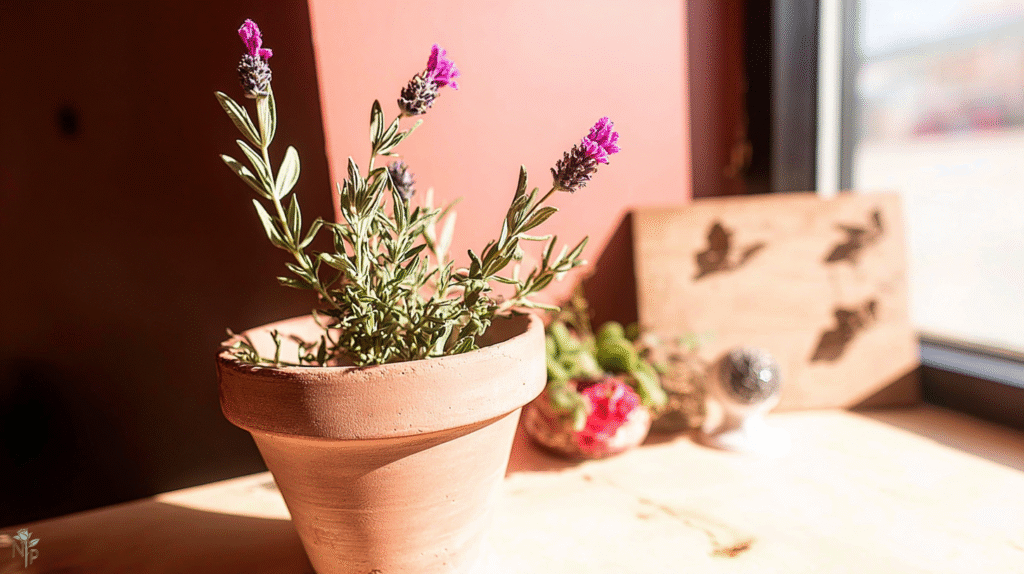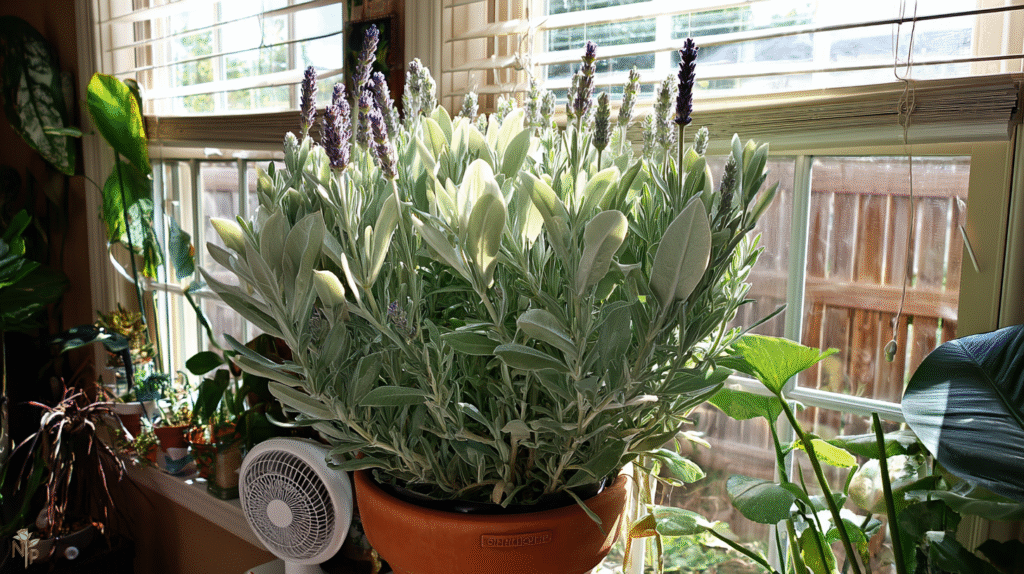My first indoor lavender died in 12 days. Twelve. Days. This supposedly “easy Mediterranean herb” turned gray, then brown, then crispy. I’d placed it on my “brightest” windowsill (north-facing, I’m an idiot) and kept my apartment at a steady 72°F because that’s what humans like.
Turns out lavender doesn’t care what humans like. It wants to live on a hillside in Provence getting blasted by sun and experiencing actual seasons. Not sitting in my climate-controlled apartment getting 2 hours of weak filtered light.
Five dead lavenders and about $75 later, I finally have two thriving plants – one that actually bloomed indoors, which the garden center lady said was “unlikely.” Here’s what nobody explains about growing lavender inside: you’re not growing a houseplant, you’re convincing a Mediterranean shrub that your living room is Southern France.

Light Requirements: More Than You Think Possible
The Full Sun Reality Check
When lavender tags say “full sun,” they mean FULL sun. Not bright indirect. Not sunny windowsill. They mean 6-8 hours of direct, unfiltered, burning sunshine. The kind that makes you squint.
My “bright” north window? 100 foot candles on a good day. Lavender wants 2000+ FC. That’s like comparing a birthday candle to a bonfire. No wonder my first three plants died – they were basically in a cave.
South Window or Bust
After killing plants in every other window, here’s the truth: without a south-facing window, you’re fighting a losing battle. My current setup:
- South window, no curtains, no filters
- Plant touching the glass (yes, really)
- Getting sun from 10 AM to 4 PM minimum
- Rotating weekly so all sides get blasted
Even this barely meets minimum requirements. In December, when sun hours drop to maybe 4 hours, growth completely stops. It’s just surviving, not thriving.
The Grow Light Investment
Bought a full spectrum LED grow light for $45 after lavender number four died. Not the purple ones – those make your room look like a crime scene. The white ones that actually mimic sunlight.
Position: 6 inches from plant top Duration: 14-16 hours daily (yes, really) Result: Actual new growth in winter
My electricity bill went up maybe $5/month. Worth it to not watch another $15 plant slowly starve from lack of light. The lavender under the grow light actually looks better than my window one in winter.
Temperature: The Complicated Dance
Daytime Heat Requirements
Lavender wants it warm during the day – 70-80°F ideal. But here’s what nobody mentions: it also wants temperature fluctuation. My apartment at constant 72°F was apparently plant purgatory.
Now I let temps swing:
- Day: 73-78°F (depending on sun through window)
- Night: 60-65°F (I turn heat down, wear sweaters)
This 10-15 degree swing mimics outdoor conditions. First time I did this, my struggling lavender pushed out new growth within two weeks. My heating bill dropped too, so win-win.
Critical Night Temperature Drops
This is what killed lavender number two – no night temperature drop. Lavender needs cooler nights to properly rest and process energy from photosynthesis. Constant temperature = confused plant = dead plant.
In summer, I crack the window at night. In winter, I move it to the coolest room (spare bedroom, heat vent closed). Pain in the ass? Yes. But it’s the difference between a thriving plant and expensive compost.
Winter Dormancy Needs
Here’s what nobody tells you: indoor lavender needs winter dormancy or it exhausts itself and dies. Not full dormancy like outdoor plants, but a rest period.
December through February:
- Reduce temperature to 60-65°F max
- Reduce watering to once monthly
- Accept that growth stops
- Don’t fertilize at all
I tried keeping mine at summer conditions year-round. It grew constantly for 10 months then suddenly died. Burned itself out. Now I enforce winter rest and they come back stronger each spring.
The Specific Variety Matters
English Lavender (Lavandula angustifolia)
Most cold-hardy but worst for indoors. Needs serious winter chill (below 50°F) for proper dormancy. Mine survived one winter then died the second spring. Now I only grow English lavender outside.
French Lavender (Lavandula dentata)
My current success story. Tolerates indoor conditions better, doesn’t need as much winter chill. Still demanding but possible. This is the one that bloomed indoors after 18 months.
Spanish Lavender (Lavandula stoechas)
Pretty but even fussier than English. Wants hot days, cool nights, and perfect drainage. Killed two before giving up. Maybe possible in Arizona, not in my Midwest apartment.
Creating the Right Environment
Air Circulation Is Crucial
Stagnant air = fungal problems = dead lavender. Learned this when my bathroom lavender (seemed logical – Mediterranean climate, right?) developed gray mold despite perfect light from the skylight.
Now all my lavenders have a small fan running nearby. Not directly on them – that dries them too fast. Just enough to keep air moving. Haven’t had fungal problems since.
Humidity Paradox
Lavender wants dry air (40% humidity max) but most apartments in winter are TOO dry (20-30%). The solution isn’t adding humidity – it’s grouping with other plants that transpire moisture. Creates a slightly more humid microclimate without making it swampy.
My lavender sits between two rosemary plants. They create just enough ambient moisture without raising humidity to dangerous levels. Took me three dead plants to figure this balance out.
The Window Placement Strategy
Distance from glass matters by season:
- Summer: 6 inches back (glass gets too hot, can burn)
- Winter: Touching glass (maximizes weak sun exposure)
- Spring/Fall: 2-3 inches (balanced exposure)
Sounds excessive but the difference is noticeable. My summer-burned lavender took six months to recover from being against hot glass in July.

Common Indoor Problems
Leggy Growth
Stems stretching with huge gaps between leaves = insufficient light. No fixing this except more light. I tried pruning to encourage bushiness. Just got leggy growth from multiple spots instead of one.
Gray Mold
Fuzzy gray stuff on stems, especially near soil. Caused by high humidity + poor air circulation. Cut affected parts immediately, improve airflow, reduce watering. Saved one plant this way, lost two others that I caught too late.
No Flowers Indoors
Most indoor lavenders never bloom. Mine took 18 months and only produced three flower spikes. If you want lavender for flowers, grow it outside. Indoor lavender is basically an attractive green plant that smells nice when you brush against it.
My Current Success Setup
The Window Champion
- French lavender in 8-inch terracotta pot
- South window, no obstruction
- Small fan 3 feet away on low
- Day temp: 75°F, Night: 62°F
- Water every 2-3 weeks when soil is bone dry
- Has survived 2 years, even bloomed once
The Grow Light Experiment
- French lavender under LED grow light
- 14 hours light daily on timer
- Bedroom (cooler at night naturally)
- Actually growing faster than window plant
- No blooms yet but healthier-looking foliage
The Failures I’ve Accepted
English lavender indoors: Given up, they need real winter Spanish lavender: Too fussy for my conditions Expecting abundant blooms: Outdoor plant behavior, not indoor Perfect-looking plants: Indoor lavender always looks a bit stressed

The Honest Truth About Indoor Lavender
Growing lavender indoors is like keeping a dolphin in a swimming pool – possible but not ideal. It’ll never look as good as outdoor lavender. It probably won’t bloom much if at all. It needs more light than seems reasonable and temperature swings that make your heating bill weird.
But when you nail the conditions and that Mediterranean smell fills your room? When you brush against it and get that instant aromatherapy hit? When it actually survives a full year and pushes out new silvery growth? Totally worth the effort.
Just remember: This isn’t a houseplant. It’s a sun-worshipping Mediterranean shrub that you’re keeping hostage. Give it blazing light (south window or grow light), temperature swings (warm days, cool nights), and barely any water. Do that and you might actually keep one alive.
Most importantly, start with French lavender, not English. Trust me on this one. I’ve got the dead plant receipts to prove it.






